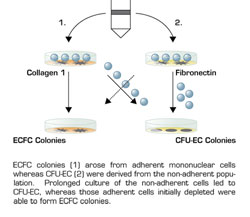In Brief
The connection between early hematopoietic precursors and the ability to form blood vessels or support blood cell development continues to be defined, and this paper moves us one step closer to understanding the divide between these processes. The investigators do a careful job of delineating differences between the two populations of cells and note that previous identification of the precursor cells was defined by cell surface markers that may have selected for a population of cells with hematopoietic potential. Their assay relies on growth and colony formation in cell culture on defined surfaces and demonstrates that, from a pooled population of mononuclear blood cells, there were cells capable of both replicating and forming blood vessels that did not have hematopoietic markers. In contrast, the CFU-ECs cells did not replicate and were not capable of forming blood vessels. In part, the identification of unique populations may be obscured by the selection markers used, and, as the authors point out, the vascular formation potential of the cells was not reviewed — this may be a necessary component of analysis. With clearer insight into the cells of interest, it may be time to revisit cell-based therapy and characterize the molecular connection between these two populations of cells.
Competing Interests
Dr. Petruzzelli indicated no relevant conflicts of interest.

